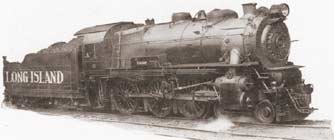
Page 30

In 1910 the Glendale Cut-Off was built from Whitepot to Glendale junction and was electrified. It was double track and allowed electric trains to be run from New York direct to the Rockaways over the Trestle. A second track on the Main Line from Long Island City to Woodside had been built in 1892, and this track was continued to Jamaica in 1903. In 1910-11 the line was made four-track all the way to Jamaica, there being an extra two tracks between Long Island City and Winfield for the North Side Division, and an extra two were built from Winfield to Whitepot for the Glendale Cut-Off. In November, 1915, the Woodside Cut-Off from Stryker Avenue, Woodside, to Maurice Avenue, Winfield, was opened. It was located north of the old line, straightening it between these two points. This made the entire route to Jamaica absolutely without grade crossings. In 1910 a fourth track was built from Springfield junction to Valley Stream, and a third and a fourth to Lynbrook, whence a second track was built on the Long Beach Branch to East Rockaway. At this time the Long Beach Branch was electrified and a concrete sub-station erected at Wreck Lead in 1913. All the trestle work across the meadows was filled in. At Long Beach an exchange of property was made whereby the curve along the beach was eliminated and a new terminal erected.
The Montauk Freight Cut-Off was opened in 1910. From the time of the leasing of the old South Side Railroad in 1876 by the Long Island Railroad, most of the traffic from the Island of Manhattan and Long Island City was carried in steam trains over the Montauk Division through Richmond Hill.
The third rail was also laid over the Central Railroad out to Clinton Road, Garden City, and over the old Hempstead Branch from Hempstead Crossing to Mineola in 1908. The sub-station at Mineola was to provide for the future electrification to Oyster Bay. Second track on the Oyster Bay Branch from Roslyn to Glen Cove in 1910, and to Locust Valley in 1912, was opened for this same reason. In 1911 a second track from Hicksville through Syosset on the North Shore Branch was opened.
May 1, 1908, the Interborough Subway tunnel from Flatbush and Atlantic Avenues, Brooklyn, to Bowling Green, Manhattan, was opened. This provided a rapid means of transportation from Long Island to Manhattan and a through connection with the New York Subway. It cut the time it took to reach Long Island points from lower Manhattan by twenty to thirty minutes, and increased the traffic handled at the Flatbush Avenue Terminal of the Long Island Railroad enormously from the day it was opened. It still remains the most important gateway to Manhattan, though much traffic was diverted to the Pennsylvania Station two years later.
In 1910 the Pennsylvania Railroad had completed its terminal in New York City, which was connected by tunnels to New Jersey, and under the East River to Long Island. At Sunnyside the large yard of the Pennsylvania Railroad was constructed. An agreement was made with that Railroad and the Pennsylvania Tunnel and Terminal Railroad Company whereby the cars of the Long Island Railroad would be carried through the tunnels under the East River into the Terminal at Seventh Avenue and Thirty-second Street, New York. Thus the Long Island Railroad acquired what successive administrations had striven for in vain, a terminal on Manhattan Island. In order to reach this terminal it was necessary to electrify from Jamaica to New York, which was accomplished in 1910, and the first train run into the Pennsylvania Station on September 10th of that year.

The Long Island was proud of this new G-5-s 10-wheeler locomotive in 1925, fresh from the Alttona Shops of the Pennsy, where it had been built. The "G" in its class designation stood for its 4-6-0 wheel arrangement. Larger image (27.5K)
Updated
©2001 The Composing Stack Inc. All right reserved